Sound Design
Regarding sound design, we created sound effects and ambiences by drawing from mythology and pictures of deep-sea environments to deliver a sense of thalassophobia.
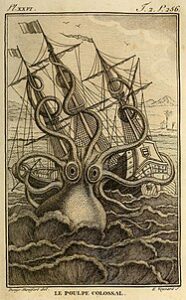
Figure 1: A Picture of Kraken.
Inspired by the Kraken, we crafted a sound effect according to its physical features, designed to evoke a sense of encountering a terrifying sea monster. Kraken is an octopus-like monster with enormous size and slimy skin (see Figure 1). Thus, the created sound effect is boosted at low frequency to highlight this giant monster. Building upon this, we also added liquid features in the sound effect to convey the slimy texture of the monster’s skin.
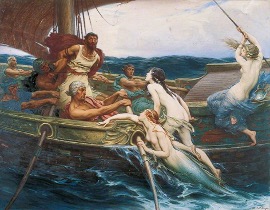
Figure 2: A Picture of Sirens.
Sirens, according to ancient Greek mythology, are humanoid creatures with alluring voices, upper human bodies, and fishtails (see Figure 2). They lured the sailors to their deaths with their songs. Therefore, we designed a sound effect with a harsh, high-frequency tone associated with Sirens’ haunting melodies.
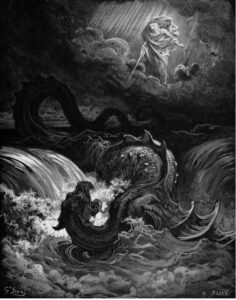
Figure 3: A Picture of Leviathan.
Leviathan is described as a colossal sea serpent or whale-like creature with formidable features (see Figure 3). To present its features, we crafted a low-frequency hollow sound effect.
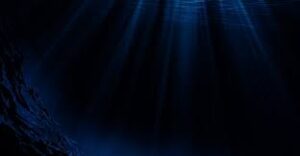
Figure 4: A Picture of Deep-sea Ambience.
The underwater ambient sound we crafted reflected the fear of the deep sea. Instead of pursuing realism, we created an abstract undersea ambience, intensifying feelings of oppression. This sound effect focused on low frequency and had significant reverb, creating a fear of the unknown and an unfathomable expanse.
The gentle white noise presented a sense of calmness with a minimalist approach.
Composition
The ‘composition’ section of the project only considers certain aspects of the sound-world. Arguably all of the sound-world can be considered part of the music composition. This is particularly true if one echoes composer John Cage’s philosophy towards music, as Cage believed that all sounds, in any form, are music (Hill, 2018). However, the separation between ‘sound design’ and ‘composition’ in discussing this project serves the purpose of separating and understanding each of our own disciplines. In this project, the discussion around ‘sound design’ deals much more with the broader soundscape, whilst the ‘composition’ deals more with harmony, and more ‘defined’ pitch (although it must be acknowledged that these ideas will overlap).
The harmonic content is going to be ordered in an aleatoric, or at least a quasi-aleatoric, manner. Aleatoric music is a form of musical composition where aspects of the composition are left up to chance, either in the pre-compositional stage, or left to the control of someone outwith the initial composition process (Latham, 2011, p. 10). The aleatoric aspect will be based on the audience’s interaction with the installation, likely being connected to the visual responses.
The harmonic construction is based on the theme of thalassophobia. From this theme, there were two methods of harmonic construction: mirror harmony and spectral harmonic techniques. Mirror harmony is a form of harmony where the same space between intervals occurs both ascending and descending from a central pitch (Persichetti, 1961, p. 173). Here are four examples.
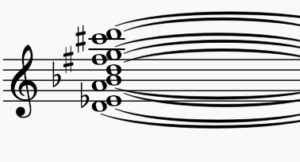
Figure 5: Mirror Harmony 1
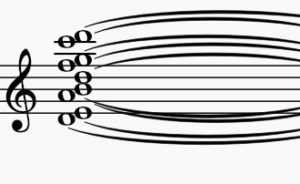
Figure 6: Mirror Harmony 2
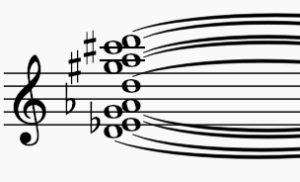
Figure 7: Mirror Harmony 3
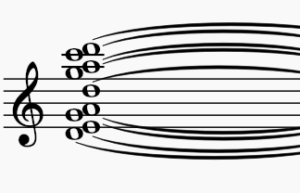
Figure 8: Mirror Harmony 4
The use of these harmonies is tied to the deep-sea aesthetic, mostly because of the reflective nature of the ocean. Further emphasizing the theme of the sea is the timbre used. The instrumentation used is a reversed MIDI vibraphone, that was then saturated with reverb, delay and chorus. This gives a timbral quality somewhat similar to the glass harmonica, an instrument which requires the use of water to produce sound (Latham, 2011, p. 23).
The other approach taken is a common technique used in spectral music. Spectral music, or spectralism, is a musical style emerging in the 1970s where the musical compositions are based on the natural spectra and/or acoustics of certain sounds (Harvey, 2000). A common spectral technique involves deriving harmony based off of the prominent partials that are shown in a spectrogram of a sound (Fineberg, 2000). This can be seen in the Gérard Grisey work Partiels, where the harmony is based on the spectral analysis of a low E on a trombone (Hasegawa, 2009). For this project, the harmony was based on the spectral analysis of whale song. Two chords are based on a whale chorus, and the other two are based on a blue whale. These chords were formed by using SPEAR for the spectral analysis, and then Openmusic, to translate the partials into sheet music, forming these ‘whalesong chords’.
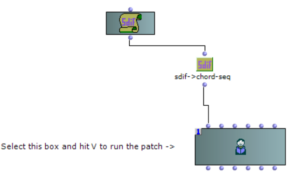
Figure 9: Image of a spectrogram-chord generator on Openmusic.
Here are the chords that were created from this.
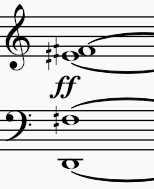
Figure 10: Blue whale chord 1
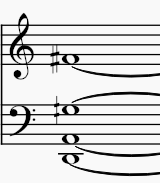
Figure 11: Blue whale chord 2
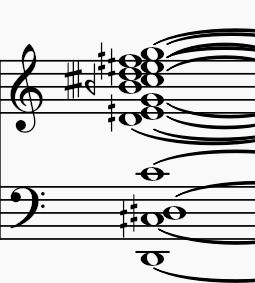
Figure 12: Whale chorus chord 1
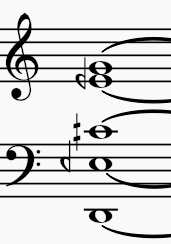
Figure 13: Whale chorus chord 2
The deep-sea representation is arguably quite obvious. However, there is broader representation of thalassophobia within these chords. For example, the fear of the unknown; the spectral harmony ‘masks’ the real sounds of a whale to something much more abstract and unidentifiable.
Both of the harmonic approaches also have deeper implications to the broader themes of fear/thalassophobia. The ‘whalesong chords’ have differing degrees of density and sparseness, which can arguably represent physical fear and calmness respectively. Returning to the mirror harmony, the chromatic ‘dissonant’ chords (mirror harmony 1 and 2) and the diatonic ‘consonant’ chords (mirror harmony 2 and 4) also can represent physical fear and calmness.
These latter concepts of physical fear and calmness, also occur within the production. The instrumentation uses sounds with initial attacks and long resonances (electric piano, vibraphone), which are then reversed and effected with reverb and delay. This creates a building tension, which could be seen as a representation of physical fear, and then a release of echoes fading away. This arguably functions as a release of tension, that then settles into a state of calm.
A final point to make on these chords, is that none of them fall clearly into the conventions of functional harmony. This means that they can be effectively used in an immersive sound instillation without creating any obvious harmonic direction towards an inevitable tonic.
The general conclusion to make about the harmonic construction is it’s both designed to fit with the themes of the project, whilst also being highly adaptable. These harmonies are, in general, suited well to an immersive installation, as their ordering can be very flexible.
Links to all sounds used here: DSMP chords examples (submission 1) – YouTube
Visual Component
In this project, we will utilize MaxMSP to achieve interactive visuals.
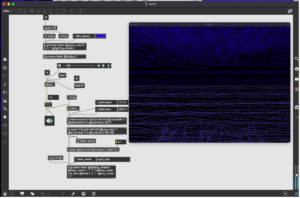
Figure 14: A Screenshot from MaxMSP.
By using matrix space, we can design the background colour and display the visuals with jit.window. We can also use the object sfplay to introduce sounds to the visuals. The sound is only used as the input source. The jit.catch~ is utilized to convert sound signals into matrix signals that can be used for images.
The visuals we intend to design will consist of abstract lines, waveforms or patterns with a dark background (see Figure 5). The deep-sea environment can significantly trigger fear because of its deep and dark characteristics (Bajwa et al., 2014, cited in Jamieson et al., 2021). Therefore, we will use Jitter to generate lines and waveforms with a pure black background, evoking abstract sensations of thalassophobia in different layers.
Furthermore, to present the final calm environment, the images can transition from a dark background with deep blue lines to a light greenish-blue background with white lines or patterns. This shift is inspired by the contrast between the deep-sea environment and shallow waters’ verdant, sunlit habitats, symbolizing new life (Jamieson et al., 2021).
The lines and waveforms produced by Jitter will possess the flexibility to transition between chaotic and peaceful states through participant interactions. This adaptability allows for dynamic changes in the interactive visuals and effectively reflects the different layers of thalassophobia experienced by participants.
Interactive Installation
The interactive installation consists of four components: the user, the sensor, the sound, and the visual projection. This setup can be divided into two subsections: first, the user triggers the sensor, and then the sensor communicates with the visuals and sounds (see Figure 6).
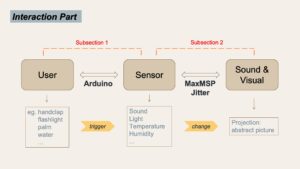
Figure 15: The Process of the Interactive Installation.
The first subsection is mainly achieved through Arduino, and the second subsection is mainly accomplished through MaxMSP and Jitter. In the first subsection, users can trigger the sensor by meeting specific trigger conditions tailored to different types of sensors (see Figure 7, Figure 8, and Figure 9). For instance, emitting a sound above a certain threshold activates the sound sensor.
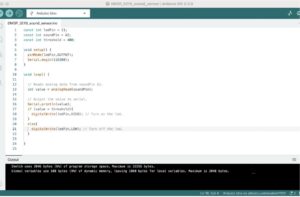
Figure 16: A Screenshot of the Sound Sensor from Arduino.
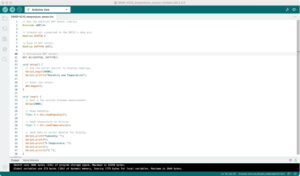
Figure 17: A Screenshot of the Temperature & Humidity Sensor from Arduino.
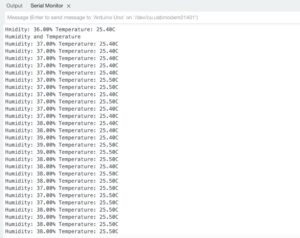
Figure 18: A Screenshot of the Temperature & Humidity Sensor from Arduino.
The second subsection primarily involves collaboration between the sensor and sounds and visuals. After triggering the sound sensor, MaxMSP and Jitter can process the data received from the sensor and translate it into dynamic changes in abstract visuals and sounds.